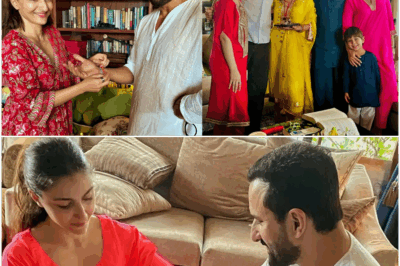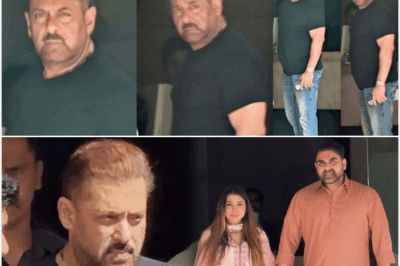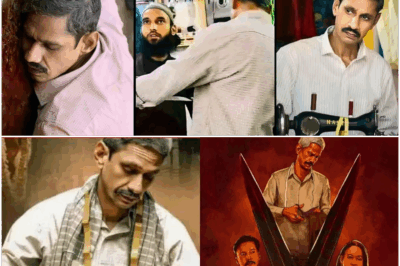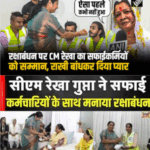Varun Dhawan got angry after seeing insensitive media coverage on Shefali Jariwala, said media has crossed the line again.
.
.
.
Varun Dhawan Slams Insensitive Media Coverage of Shefali Jariwala’s Death: A Wake-Up Call for Journalistic Ethics
Introduction
The sudden demise of actress and dancer Shefali Jariwala has left her fans, the film fraternity, and her loved ones in a state of deep shock and mourning. However, what has added to the collective grief is the nature of the media coverage that followed her passing. In the wake of Shefali’s death, a section of the media crossed the line between reporting and sensationalism—a trend that has become disturbingly common in the coverage of celebrity tragedies in India.
Bollywood actor Varun Dhawan, known for his cordial relationship with the media and paparazzi, has publicly expressed his dismay at the insensitivity displayed by sections of the press. His candid remarks have reignited the debate over the ethics of media coverage during moments of profound personal loss, not just for Shefali but for many celebrities before her.

The Incident That Sparked Outrage
Shefali Jariwala’s untimely death sent shockwaves across the country. As condolences poured in, so did a wave of media attention—some of it compassionate, but much of it crossing the boundaries of respectful journalism. Early morning after Shefali’s passing, her husband Parag Tyagi was seen walking their dog, Simba. What should have been a private, personal moment soon became fodder for intrusive media coverage.
Several news channels and digital outlets ran stories questioning Parag’s demeanor, with some even suggesting that his facial expressions did not reflect the “appropriate” amount of grief. Such coverage not only invaded his privacy but also subjected him to public judgment at a time when he was grappling with an unimaginable loss.
A Pattern of Sensationalism
This was not the first time the Indian media’s approach to covering celebrity deaths has come under scrutiny. From the tragic losses of Sushant Singh Rajput and Sidharth Shukla to the passing of legendary actress Sridevi, each incident has seen a similar pattern: intense, sometimes chaotic coverage, speculation, and, at times, outright character assassination.
In Shefali’s case, the relentless pursuit of sensational headlines led to a barrage of baseless accusations and insensitive questioning. The media’s focus shifted from reporting facts to dissecting the emotional responses of the bereaved, often with little regard for their mental state or dignity.
Industry Voices Speak Out
The insensitivity did not go unnoticed. Paras Chhabra, a close friend of Shefali and Parag, was among the first to react strongly. He directly confronted the channel that had aired the controversial video, questioning their motives and ethics: “We saw your video. How can you ask such questions? What kind of coverage is this?”
Many others from the film and television industry echoed his sentiments. They highlighted the need for empathy and restraint, especially when covering events as delicate as someone’s final journey. The consensus was clear: the media must remember that behind every headline is a grieving family, and every clickbait story comes at the cost of someone’s pain.
Varun Dhawan’s Powerful Statement
Varun Dhawan, a popular actor known for his affable interactions with the media, took a stand against the ongoing trend of insensitive reporting. In a heartfelt Instagram post, he wrote:
“Again, one more passing of a soul being insensitively covered by the media. I just don’t understand—why do you have to cover someone’s grief? Everyone looks so uncomfortable with this. How is this benefiting anyone? My request to my friends in the media: this isn’t the way someone would want their final journey covered.”
Varun’s words resonated with millions. His post was widely shared, sparking conversations about the need for compassion and responsibility in journalism, especially when dealing with loss and mourning.
The Media’s Role: Reporting or Intruding?
The core question raised by Varun Dhawan and others is fundamental: What is the media’s role when it comes to reporting on personal tragedies? Is it to inform the public, or to intrude upon private grief for the sake of viewership and engagement?
The answer, unfortunately, seems to blur in the face of fierce competition for ratings and online traffic. In the rush to be first, to be exclusive, or to generate viral content, the lines of ethical journalism are often crossed. The result is a coverage style that is not just insensitive, but potentially harmful—both to those directly affected and to the broader public discourse.
A Recurring Problem
The issue of insensitive media coverage is not new. The deaths of Sridevi, Sushant Singh Rajput, and Sidharth Shukla all saw similar patterns: media vans crowding outside homes and hospitals, reporters thrusting microphones into the faces of grieving relatives, and endless speculation about causes and circumstances—all before the facts were even established.
In each case, the media’s actions drew criticism from the public and industry insiders alike. Yet, the cycle repeats with each new tragedy, suggesting a systemic problem that goes beyond individual reporters or channels.
The Impact on the Bereaved
For those who have lost a loved one, the pain of grief is often compounded by the glare of the media spotlight. Instead of being allowed to mourn in peace, families are subjected to public scrutiny, their actions and emotions dissected and judged by strangers.
In Parag Tyagi’s case, the simple act of walking his dog—a routine that may have provided a brief moment of solace—became the subject of national debate. Media outlets questioned his lack of visible grief, ignoring the fact that everyone processes loss differently. Such coverage not only invades privacy but can also have severe psychological consequences, including anxiety, depression, and trauma.
The Ethics of Coverage: Where Should the Line Be Drawn?
The debate over media ethics is not limited to India. Around the world, journalists grapple with the challenge of balancing the public’s right to know with the rights of individuals to privacy and dignity. The Society of Professional Journalists’ Code of Ethics, for example, urges reporters to “show compassion for those who may be affected by news coverage” and to “recognize that gathering and reporting information may cause harm or discomfort.”
In the race for exclusives, these principles are too often forgotten. The coverage of Shefali Jariwala’s death has once again highlighted the urgent need for media organizations to revisit their guidelines and train their staff in ethical reporting.
Public Backlash and the Call for Change
The public response to the coverage of Shefali’s death was swift and unequivocal. Social media platforms were flooded with messages condemning the media’s approach, and hashtags demanding respectful journalism trended for days.
Many users pointed out that grief is deeply personal and cannot be measured by outward expressions. Others called for stricter regulation of media practices, including penalties for channels that cross ethical boundaries.
Lessons from the Past
India’s media landscape has seen similar calls for reform in the past, especially after high-profile tragedies. Yet, meaningful change has been slow to come. The allure of higher ratings and viral content often outweighs the imperative for responsible reporting.
However, as more celebrities and public figures like Varun Dhawan speak out, there is hope that the tide may be turning. Their voices lend weight to the argument that journalism must be rooted in humanity, not just in the pursuit of headlines.
A Plea for Sensitivity
At its core, the issue is one of sensitivity—of recognizing that news stories are not just about events, but about people. When covering loss, especially the loss of a public figure, the media has a responsibility to uphold the dignity of the deceased and the feelings of those left behind.
Varun Dhawan’s appeal to his friends in the media is a reminder that the final journey of any individual deserves respect, not spectacle. It is a call to remember that behind every story is a family, a community, and a legacy that must be honored.
Conclusion: Towards More Responsible Journalism
The coverage of Shefali Jariwala’s death has exposed, yet again, the cracks in the ethical foundations of Indian journalism. While the media plays a vital role in informing the public, it must do so with compassion, restraint, and respect for privacy.
Varun Dhawan’s stand is not just a critique, but a wake-up call for the entire industry. It is a reminder that the true measure of journalism lies not in its ability to attract viewers, but in its capacity to tell stories with integrity and empathy.
As the industry reflects on its practices, one can only hope that the lessons of this tragedy will not be forgotten. For the sake of those who grieve, and for the future of journalism itself, it is time to draw the line—and to stand firmly on the side of humanity.
play video:
News
Delhi CM Rekha Gupta celebrated Rakshabandhan by tying Rakhi to sanitation workers at Jan Seva Sadan
Delhi CM Rekha Gupta celebrated Rakshabandhan by tying Rakhi to sanitation workers at Jan Seva Sadan In a remarkable and…
The love of TV siblings overflowed, Raksha Bandhan fever gripped the stars, small screen stars were immersed in the celebrations!
The love of TV siblings overflowed, Raksha Bandhan fever gripped the stars, small screen stars were immersed in the celebrations!…
Starkids BEING JEALOUS of Aneet Padda for BEING AN OUTSIDER?| Ahaan BEING IGNORE by Starkids?
Starkids BEING JEALOUS of Aneet Padda for BEING AN OUTSIDER?| Ahaan BEING IGNORE by Starkids? Bollywood’s glittering landscape has always…
Soha Ali Khan celebrates Raksha Bandhan with Brother Saif Ali Khan at Pataudi Palace!
Soha Ali Khan celebrates Raksha Bandhan with Brother Saif Ali Khan at Pataudi Palace! . . . Soha Ali Khan…
Salman Khan Looks Older with Family during Celebrate Raksha Bandhan 2025
Salman Khan Looks Older with Family during Celebrate Raksha Bandhan 2025 . . . Salman Khan Celebrates Raksha Bandhan 2025…
Today the fundamentalists must have got some relief- Udaipur Files Kanhaiya Lal Tailor Murder Earned Only ₹1 Lakh
Today the fundamentalists must have got some relief- Udaipur Files Kanhaiya Lal Tailor Murder Earned Only ₹1 Lakh . ….
End of content
No more pages to load









